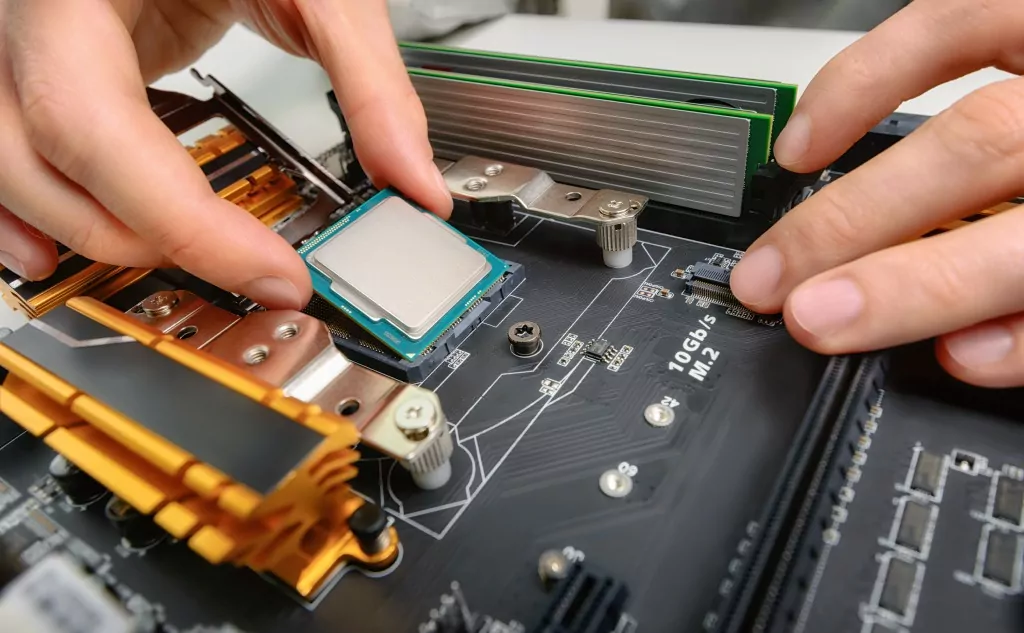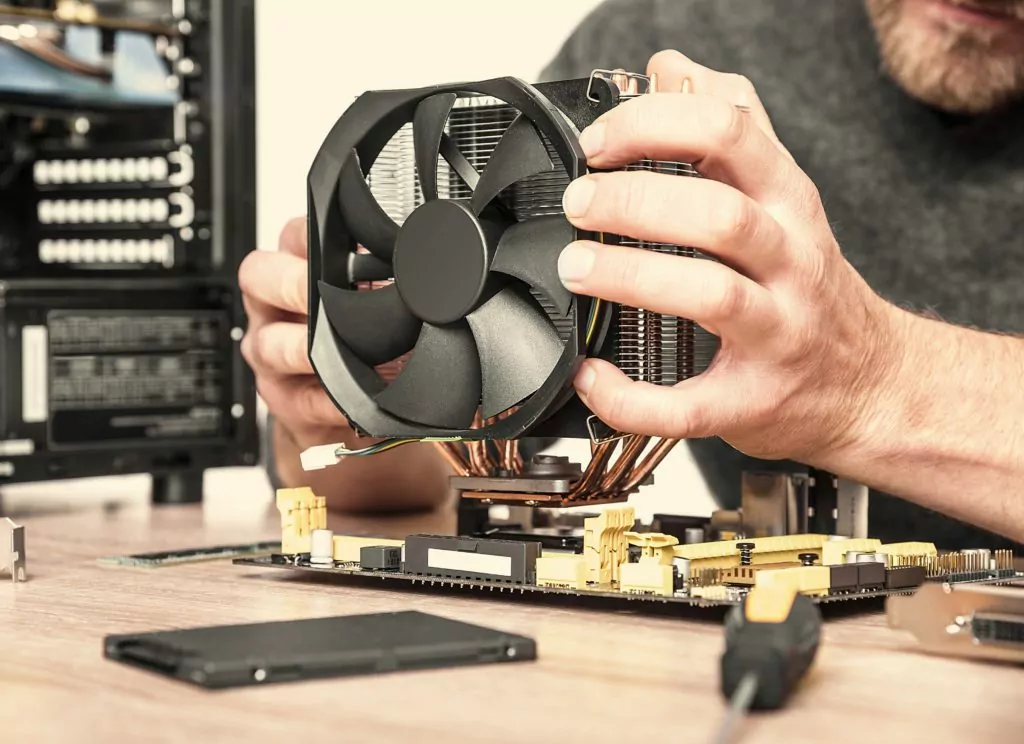Here are the 12 best computer architecture books.
Learn why each book made the list and what it is about.
So if you want to know what the best computer architecture books are, then this article is for you.
Let’s get started!

What to Look for in a Computer Architecture Book
The first thing to do when choosing a computer architecture book is to make sure you’re picking a book that is a good fit for your level.
If you’re taking your first computer architecture class, the best computer architecture book for your needs should define all the essential concepts in a manner that is accessible.
You should also consider the scope of the book. It’s a good idea to invest in a few textbooks that provide you with a comprehensive overview of the different components, their functions, and other important concepts.
As you learn more about computer architecture, you will probably develop an interest in specific areas of study, some questions you want to answer, and some components you want to learn how to design.
You can then start looking for books with a more specific focus.
We recommend taking a few minutes to research the author before purchasing a computer architecture book.
Find out what their credentials are and look for books written by people who are instructors or renowned experts in their fields.
It’s best to pick a book written by someone who has published several papers on a topic or who teaches at a major university.
Pay attention to the publication date and edition. You can usually find lower prices when shopping for older editions of textbooks, but computer architecture is a topic where you need recent material.
The book you choose should reflect current technology and use modern devices as examples.
Your learning style is also important when choosing a book.
Do you retain information better through practice problems and review questions?
Do you need to complete hands-on projects and activities to learn new concepts?
Some textbooks include exercises, practice problems, or review questions.
Some books come with extras that add value.
You can sometimes get an eBook version for free, digital learning resources, and more.
Best Computer Architecture Books
The following titles are some of the best computer architecture books available.

You will find a mix of textbooks suitable for undergrad students and books that discuss more advanced concepts.
Essentials of Computer Architecture, 2nd, by Douglas Comer
With over 500 pages, this textbook is the best computer architecture book for you if you’re looking for a comprehensive survey of all the essential concepts you need to master.
This textbook is an introduction to computer architecture, and you will learn key concepts linked to hardware in the context of programming.
You will learn about topics like digital logic, processors, memories, and I/O systems.
This book also includes introductory chapters that discuss more advanced ideas, like pipelining or strategies you can use to improve the performance of a computer.
The content can feel academic at times, but the book remains easy to read.
There is a lab component that gives you the opportunity to apply the concepts you’re learning with a more hands-on approach.
The author, Douglas Comer, is an expert on the TCP/IP protocol and other topics related to the internet.
He has been studying these concepts since the 1970s and has an impressive resume that includes creating courses on computer architecture and related topics.
The main drawback of this book is that it caters to programmers.
While it’s important to study computer architecture concepts as they apply to programming, you should supplement this textbook with additional material that doesn’t focus on what programmers need to know.
Pros:
- Covers all the key concepts
- Easy to read
- Lab component
- Well-organized with five different sections
Cons:
- Geared towards programmers
- You might need something more advanced if you’re new to computer architecture
Computer Architecture: Fundamentals and Principles of Computer Design, 2nd Edition, by Joseph D. Dumas II
This computer architecture textbook is ideal for the undergraduate level.
The material is accessible as long as you are familiar with computer organization, digital logic, and some basic programming concepts.

We like this textbook because of how comprehensive it is. It gives you an introduction to the more abstract concepts tied to computer architecture, and you will also learn about the different components of a computer in a more-hands fashion.
Each chapter introduces a new topic and provides you with the material you need to develop a good understanding of the abstract concepts behind this topic.
The chapter will then move on to a more practical approach and show you how to apply these concepts in computer architecture.
We recommend this textbook if you’re studying computer architecture by yourself. Each chapter starts with an introduction to the topic before covering the main points.
You will find a review at the end of each chapter that helps you assess how well you have mastered different concepts.
You will also find some questions to help you develop a deeper understanding of the different topics discussed.
The writing is noteworthy. While some computer architecture textbooks can feel a little academic, this book is very accessible and easy to read.
The author explains things in a clear and concise fashion and uses visual aids to illustrate important concepts.
Pros:
- Great introduction to important concepts
- Learn about the different components of computer architecture
- Writing is accessible
- Suitable for undergraduate courses
Cons:
- You should possess some knowledge in areas like programming and data logic
- No labs or hands-on activities
Essentials of Computer Organization and Architecture, 5th Edition, by Linda Null and Julia Lobur
Now in its fifth edition, this textbook is essential reading if you’re studying computer architecture at the college level.
Each edition features updated content that reflects the rapidly changing field of computers.
This fifth edition dates from 2018 and feels up to date, but keep in mind that a sixth edition might be available soon.
One of the main draws of this textbook is the additional resources you get when you purchase it. These resources add value for instructors, and you can also use these resources if you’re studying by yourself.
This award-winning textbook provides you with over 700 pages of content. It introduces key computer architecture concepts and uses real-world examples to illustrate them.
Some textbooks take a more abstract and academic approach to discuss computer architecture but relying on real-world examples makes important concepts feel more concrete and prepares you for a career in the field of computer architecture.
The textbook also covers ACM/IEEE guidelines for computer organization and architecture. Learning about these guidelines will give you an advantage once you find a job in computer architecture.
You will get access to additional resources when you purchase this textbook.
There is a collection of online resources with an eBook version of the textbook with some interactive features, some additional activities, and quizzes you can use to test your knowledge. Instructors can access more material.

These resources add value to the textbook, and the activities and quizzes will come in handy if you’re a student who learns better when they can apply the concepts they just read about.
Pros:
- One of the most comprehensive computer architecture textbooks
- Additional learning resources
- Uses real-world examples
- Introduces important concepts for a career in the field of computer architecture
Cons:
- You might need to replace this textbook with the 6th edition in a few years
- Some students report finding typos in this edition of the textbook
Computer Architecture: A Quantitative Approach (The Morgan Kaufmann Series in Computer Architecture and Design), 6th Edition, by John L. Hennessy
This classic award-winning textbook is the best computer architecture book for students who have completed some computer architecture courses and for professionals who need to catch up on the latest innovations in their field.
The sixth edition of this textbook features a lot of new material. There are new chapters about topics like processors, system architecture, and stacked memory. You will also find new content that looks at modern systems like warehouse-scale computers and data centers.
This textbook will introduce you to the RISC-V architecture standard. You can find the entire standard published in this book, and there are different real-world examples to illustrate it.
Learning about the RISC-V standard is a practical skill that can give you an edge when applying for a computer architecture position.
We like this textbook because it takes everything that is complex about computer architecture and design and makes it accessible. It explores every aspect of the different topics discussed in a thorough manner.
We also like the practical approach this textbook takes. It uses current computer architecture standards and basic engineering principles that you need to know about to design systems with performance and efficiency in mind.
Each chapter discusses a different concept in depth before providing you with real-world examples.
You will also find comprehensive review sections and can access additional reviews online. We like these review sections before they’re a convenient way to study for a test or get a quick refresher on a topic.
You will find case studies that look at real-world examples in detail and provide you with concrete data that illustrate the different concepts you’re studying.
Each chapter also has some exercises you can use to practice and test your knowledge.
Pros:
- Plenty of real-world examples
- Ideal if you want to learn about the latest changes in the field of computer architecture
- Uses current RISC V standard and engineering concepts
- Includes reviews, case studies, and exercises
Cons:
- Some readers don’t like the way the author organized the chapters
- Longer and heavier than other textbooks
The Elements of Computing Systems: Building a Modern Computer from First Principles, by Noam Nisan
We recommend this book because it approaches computer architecture from its software-hardware interaction definition.
The author organizes the information so that you can learn how to build a computer from scratch.

The first half of the book covers the different hardware components, and you will learn about software hierarchy in the second half. The book paints a comprehensive picture of the process of building your own computer.
We like the hands-on approach because you can learn a lot about computer architecture by following along and building a computer.
The writing feels clear and concise, and the book connects abstract concepts to concrete applications.
Applied computer science is an element that is often missing from academic textbooks.
Mastering abstract concepts is essential, but these concepts often become a lot clearer once you start applying them through hands-on projects.
This book has a total of twelve chapters that include an overview of each topic and a project you can complete.
You can complete the twelve projects independently from each other. You will know enough to build your own computer once you complete all the different projects.
The author has an official website where you will find additional resources, including test programs for the different projects.
Pros:
- Learn key principles and apply them
- Learn how to build your own computer
- Complete twelve projects to apply different computer architecture concepts
- Additional resources available online
Cons:
- You will have to invest in hardware to apply what you learn and build your own computer
- A newer version of this textbook will be available later in 2021
Modern Computer Architecture and Organization, by Jim Ledin
This book is a guide to the recent innovations that are shaping the world of computer architecture. It also covers basic topics like transistors, circuitry, logic gates, pipelining, and more.
You can use this book to learn about best design practices by studying ARM and RISC-V processors, among other devices.
The book uses several real-world examples with modern devices like the iPhone, gaming PCs, or cloud servers.
We like this book because it covers an impressive scope. It discusses every hardware component in detail and introduces you to concepts that are important for thinking about the bigger picture and designing networks.
There is an emphasis on creating systems that are performing and scalable, two important ideas you will encounter when working on computer architecture projects in a professional setting.
You will also learn about innovations like quantum computers and virtual machines.
The book features fourteen chapters that mix basic computer architecture concepts and innovations. There are exercises and activities that will teach you how to implement a processor or write a program.
It’s a great book if you’re close to graduating and want something that will bring you up to date on the latest innovations in your field.
Pros:
- Excellent survey of recent innovations
- Covers key concepts
- Includes exercises and activities
- Discusses smartphones and other devices
Cons:
- Chapters about basic concepts might not feel useful for advanced students
- The activities require previous coursework
Schaum’s Outline of Computer Architecture, by Nick Carter
We highly recommend this study guide if you’re taking a computer architecture class and feel a little lost. It’s shorter than other books, but you can use this study guide as a reference to look up core computer architecture concepts whenever you need a quick refresher.

We like this book because it’s short and straight to the point. There are different tools that will help you retain information and ensure that you fully understand all the different computer architecture concepts.
You will find different chapters that explain all the fundamentals of computer architecture. This content isn’t as detailed as other books, but it will sum up what your instructor explained in class. It’s a great resource for getting a refresher before a test or supplementing your notes.
You will find chapter summaries if you need a quick definition of an important concept, more than 200 practice problems with step-by-step solutions, and some review questions to help you study.
Even though the book is short, it covers a wide range of topics, including instruction sets, cache, memories, I/O systems, pipelining, logic, parallelism, processors, and more.
Think of this book as a reference or go-to study guide. The information is easy to understand, and it’s a great tool to have if you’re taking a computer architecture class that feels challenging.
Pros:
- Study guide format
- Plenty of problems and review questions
- Covers a comprehensive range of topics
- Ideal for undergrad students
Cons:
- Not as detailed as other books
- Some sections feel dated
Learning Computer Architecture with Raspberry Pi, 1st Edition, by Eben Upton, Jeffrey Duntemann, Tim Mamtora, Ralph Roberts, and Ben Everard
This book is a little different from the other textbooks on our list. It focuses on the Raspberry Pi and uses this small computer to help you learn about important computer architecture concepts.
It’s a great introduction to computer architecture and a must-have book if you want to tinker with a Raspberry Pi.
You will learn about the different components of this computer, including pins, ports, System-on-Chip, CPU, GPU, and more.
Even though the book focuses on the Raspberry Pi, the components discussed are elements you will find in all computers.
You will find chapters that discuss how the different components communicate with each other and how OS and software relate to the hardware components.
Using the Raspberry Pi as a point of reference makes complex ideas more concrete, and it will help you develop a thorough understanding of how this small computer works before you move on to studying more advanced machines.
We recommend this book because one of the co-authors, Eben Upton, is one of the creators of the Raspberry Pi.
He does a great job of discussing the thought process behind selecting the different components of the Raspberry Pi.
The focus on the Raspberry Pi makes this book a little different from what a computer architecture instructor would require you to read for class, but it’s a fun way of learning about computer architecture.
You can go further and work on DIY projects that involve a Raspberry Pi to get some hands-on experience with computer architecture after reading this book.
Pros:
- Learn about the different components of the Raspberry Pi
- Learn about how OS and software relate to hardware
- Tinkering with a Raspberry Pi is a fun project
- The simple design of the Raspberry Pi makes computer architecture more accessible
Cons:
- The focus is exclusively on the Raspberry Pi
- Readers say the book doesn’t always explain acronyms
Inside the Machine: An Illustrated Introduction to Microprocessors and Computer Architecture, 1st Edition, by Jon Stokes
This book discusses microprocessors in-depth. While a majority of computer architecture textbooks dedicate a chapter to this topic, microprocessors are complex enough to warrant reading an entire book that combines the basics of computer architecture and exploring microprocessor components.

We recommend this book because it will teach you everything there is to know about microprocessors. It uses illustrations and some real-world examples to help you understand abstract concepts.
It looks at specific microprocessors from Intel, IBM, and other manufacturers.
The main downside is that the book dates from 2006.
The real-world examples are useful, but they don’t reflect the hardware you can find in more modern devices.
You will learn about important topics like caching, pipelining, memories, and execution.
The book discusses programming concepts related to microprocessors, including memory access, data types, and more.
There are some chapters that address more advanced concepts like RISC and CISC standards, memory hierarchy, branch prediction, caching, best practices for performance, and more.
Pros:
- Study microprocessors in-depth
- Uses diagrams and real-world examples
- Covers advanced microprocessor concepts
- Learn about programming concepts related to microprocessors
Cons:
- The book is from 2006
- There are no exercises or activities
Deep Learning for Computer Architects, by Paul Whatmough, Gu-Yeon Wei, and David Brooks
This book is a compilation of lectures and papers on the topics of computer architecture and deep learning. It looks at how one can apply deep learning concepts to computer architecture and explore possible applications that could shape information technology in the near future.
We like this book because it asks new questions and explores a wide range of possible applications.
It discusses topics like using deep learning to improve performance or security.
It also looks at applications linked to memory synchronization, tuning, cache hierarchies, or memory consistency.
We recommend this book because deep learning is one of the top innovations that are currently transforming the IT field, and this book is a great way to catch up on how deep learning applies to computer architecture.
It’s also a great reference to have when writing academic papers. You will find research from experts that you can quote in your papers and some thought-provoking lectures you can use as a basis for developing your own thesis when writing assignments.
Pros:
- Research from the top experts in the field of computer architecture
- Learn about new concepts and possibilities in the field of computer architecture
- Explore how machine learning could change computer architecture in the future
Cons:
- Doesn’t use a traditional textbook structure
- Newer research on the topic is available
Computer Organization and Architecture, 11h Edition, by William Stallings
This textbook is an ideal choice if you’re looking for a comprehensive overview of computer architecture.
It’s the 11th edition, and there is plenty of new material that reflects the latest tech and research on the topic.
We like this book because the material is engaging and easy to read. There are plenty of real-world examples, and the author explains advanced concepts in a way that is very accessible.

The book begins with an introduction to computers and a history of how the different components have evolved.
It covers topics like common performance issues, I/O functions and structures, digital logic, computer arithmetic, and more.
Each chapter discusses a different topic, and it’s easy to find information about a specific topic thanks to the structure of the book.
You will find questions at the end of each chapter to review what you learned and test your knowledge.
The main downside of this book is that some chapters jump to more advanced topics and might be difficult to follow if you’re new to computer architecture.
It’s still an excellent buy for students taking advanced classes and professionals.
Pros:
- Very comprehensive overview of computer architecture principles
- Provides concrete solutions for common performance issues
- Engaging and easy to read
- Each chapter includes questions
Cons:
- Might be too complex for undergrad students
- Doesn’t include problems or exercises
Principles of Secure Processor Architecture Design, by Jakub Szefer
This book focuses on processor design and is a little more advanced than some of the other books on our list.
It’s a worthwhile read if you want to learn more about processors or if you’re considering a career in processor design.
The book contains content from a series of lectures on the topic of processor design.
It’s best for those with a solid understanding of computer architecture since the author doesn’t explain the more basic concepts.
This book focuses on the issue of security in processor design. There are a lot of interesting ideas about implementing new features that can protect the code and data on a processor.
The author also discusses important aspects like performance and energy-efficiency, but keep in mind that this book is primarily about designing safer processors.
We like this book because it presents you with concrete best practices for safer processor design, and it includes some design suggestions.
Pros:
- Recent research on the topic of security and processor design
- Includes concrete best practices you can apply
- Thought-provoking read on new issues computer architects are facing
Cons:
- Not accessible for beginners
- It narrows down to a single topic

